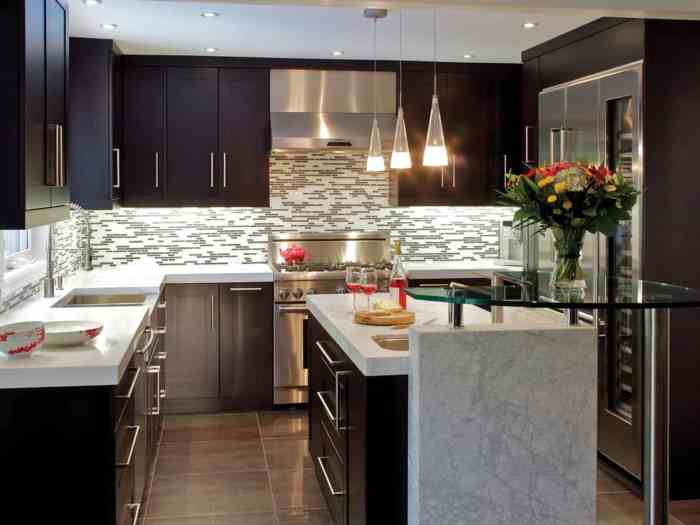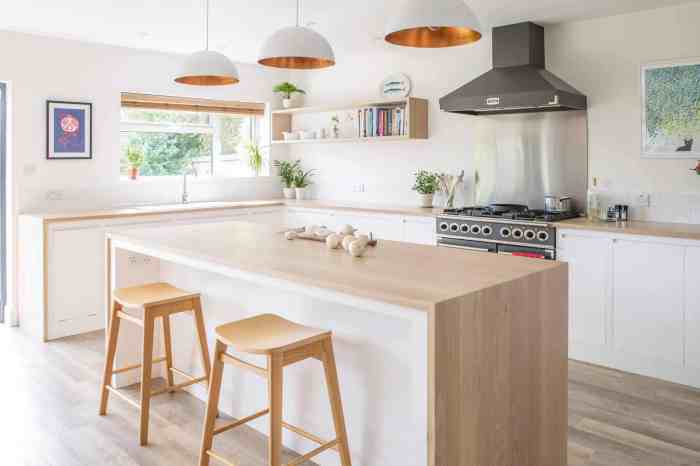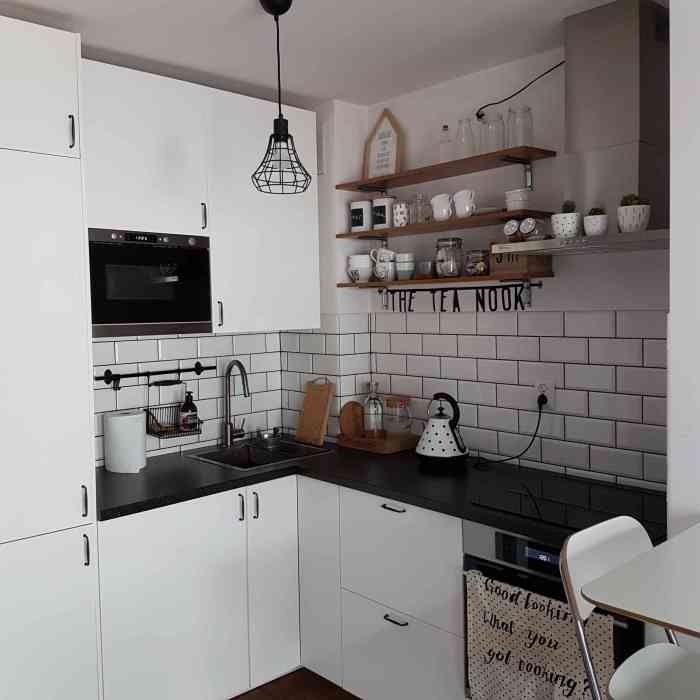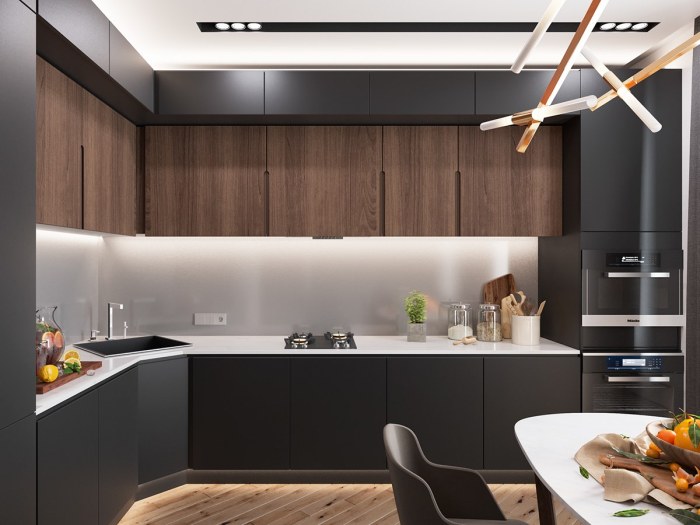The modern kitchen, a hub of culinary creativity and social gathering, often faces a spatial constraint: size. For those inhabiting smaller dwellings, the dream of a stylish, functional kitchen can seem elusive. However, the principles of minimalist design offer a powerful solution, transforming limitations into opportunities. By strategically employing space-saving techniques, carefully selecting materials and colors, and prioritizing essential appliances, even the smallest kitchen can become a haven of efficiency and aesthetic appeal.
This exploration delves into the science of spatial optimization, the psychology of color, and the art of mindful organization, revealing how a minimalist approach can unlock the full potential of a compact kitchen.
This journey will cover key aspects, from maximizing vertical space and utilizing multifunctional furniture to creating a harmonious color palette and implementing ingenious storage solutions. We’ll examine the impact of lighting on the perceived size and ambiance of the room, and discuss the selection and integration of appliances designed for efficiency in compact spaces. The goal? To empower you to design a small kitchen that is not only functional and beautiful but also reflects your personal style and enhances your daily life.
Space-Saving Design Strategies

Optimizing a small minimalist kitchen hinges on strategic design choices that maximize functionality within limited square footage. The principles of minimalism, emphasizing simplicity and functionality, align perfectly with the need for space-saving solutions. By carefully considering layout, furniture selection, and appliance integration, even the smallest kitchen can become efficient and aesthetically pleasing.
Vertical Space Maximization in Small Kitchen Layouts
Efficient use of vertical space is paramount in small kitchen design. Cabinets reaching the ceiling, for instance, dramatically increase storage capacity compared to standard-height units. Furthermore, incorporating wall-mounted shelving units for frequently used items keeps countertops clear and minimizes clutter. Strategic placement of tall, narrow cabinets can also visually elongate the space, creating an illusion of greater volume.
The following table illustrates various layouts and their associated advantages and disadvantages:
| Layout | Pros | Cons | Suitability |
|---|---|---|---|
| Galley Kitchen (Two parallel runs of counters) | Efficient use of space, excellent workflow. | Can feel cramped if too narrow, limited counter space. | Small apartments, narrow spaces. |
| L-Shaped Kitchen | Offers good counter and storage space, allows for an island or peninsula in larger L-shapes. | May not be suitable for very small spaces, can create traffic bottlenecks. | Moderate-sized kitchens, allows for flexibility. |
| U-Shaped Kitchen | Maximizes counter and storage space, ideal for larger kitchens. | Requires significant space, can feel overwhelming in a small kitchen. | Larger kitchens with sufficient space; not ideal for small spaces. |
| One-Wall Kitchen | Simple, easy to plan, requires minimal space. | Limited counter and storage space, may not be suitable for multiple cooks. | Very small kitchens, studios, or spaces with limited area. |
Multi-Functional Furniture in Small Minimalist Kitchens
Multi-functional furniture is crucial for maximizing space and minimizing visual clutter in small minimalist kitchens. The key is to select pieces that serve multiple purposes without compromising on style or functionality.
Examples of multi-functional furniture include:
- Island with integrated storage: A kitchen island can serve as a prep area, dining space, and storage unit, all in one.
- Fold-down tables: These space-saving tables can be folded away when not in use, freeing up floor space.
- Storage ottomans: These provide seating while simultaneously offering hidden storage for kitchen essentials.
- Cabinetry with integrated appliances: Cabinets that incorporate microwaves, ovens, or even dishwashers maximize space utilization.
Advantages and Disadvantages of Built-in Appliances in Small Kitchens
Built-in appliances offer a streamlined aesthetic and often maximize space efficiency in small kitchens. However, considerations regarding cost and flexibility are crucial.
Advantages:
- Space saving: Built-in appliances are designed to fit seamlessly into cabinetry, eliminating the bulkiness of freestanding units.
- Improved aesthetics: A clean, integrated look enhances the minimalist design aesthetic.
- Potential for increased efficiency: Some built-in appliances offer improved energy efficiency compared to their freestanding counterparts.
Disadvantages:
- Higher initial cost: Built-in appliances typically command a higher price tag than freestanding models.
- Limited flexibility: Replacing or upgrading built-in appliances can be more complex and expensive than swapping freestanding ones.
- Installation challenges: Professional installation is often required, adding to the overall cost.
Color Palette and Material Selection
The judicious selection of color palettes and materials is paramount in achieving a minimalist aesthetic, particularly within the confines of a small kitchen. Color psychology and material properties directly influence the perceived size, ambiance, and overall functionality of the space. Strategic choices can amplify the feeling of spaciousness, enhance light reflection, and create a calming or energizing atmosphere, depending on the desired effect.
Mood Board: Three Minimalist Kitchen Color Palettes
Creating a visually appealing and functional minimalist kitchen requires careful consideration of color. The following palettes offer diverse moods while adhering to the principles of minimalism. Each palette is presented as a conceptual mood board, describing the colors and their psychological effects.
Palette 1: Cool and Calming
This palette features a base of soft, cool grays (think dove gray or silver sage) for the walls and cabinetry. Accents are provided by pale blues and greens, evoking a sense of serenity and spaciousness. Countertops could be a light-colored stone, such as white marble or a light-grey quartz, to maintain the cool, airy feel. The psychological impact of cool colors is a reduction in perceived temperature and an increase in feelings of calm and relaxation.
Studies show that cool-toned environments can lower heart rate and blood pressure, creating a more tranquil atmosphere ideal for a kitchen.
Palette 2: Warm and Inviting
This palette utilizes warm neutrals such as creamy whites, warm beige, and light oak wood tones. Subtle accents of terracotta or muted mustard yellow can add warmth without overwhelming the space. The use of natural wood elements contributes to a cozy and inviting ambiance. Warm colors are known to stimulate appetite and promote a feeling of comfort and security.
This is particularly beneficial in a space dedicated to food preparation and consumption.
Palette 3: Monochromatic Elegance
This palette focuses on variations of a single color, for example, different shades of grey ranging from charcoal to almost white. This creates a sophisticated and unified look. Metallic accents, such as brushed nickel or stainless steel, can add visual interest and a modern touch. The monochromatic approach enhances a sense of calm and order, reflecting the minimalist ethos.
The absence of jarring color contrasts contributes to a feeling of spaciousness and sophistication.
Material Comparison in Minimalist Kitchen Design
The choice of materials significantly impacts the overall aesthetic and functionality of a minimalist kitchen. The following table compares three common materials: wood, metal, and stone.
| Material | Aesthetic Qualities | Durability & Maintenance | Cost |
|---|---|---|---|
| Wood | Warm, natural, adds texture and visual interest; can create a rustic or modern feel depending on the type and finish. | Moderate durability; requires regular maintenance (oil, sealing) to prevent damage from water and scratches. | Moderate to high, depending on the type of wood. |
| Metal (Stainless Steel, etc.) | Modern, clean, sleek; reflects light, creating a sense of spaciousness. | High durability; relatively easy to clean and maintain. | Moderate to high, depending on the finish and quality. |
| Stone (Marble, Granite, Quartz) | Elegant, luxurious; adds a touch of sophistication; various colors and patterns available. | High durability; relatively low maintenance, though some types require sealing. | High, depending on the type and quality of stone. |
Light and Airy Kitchen Design
To maximize the sense of space in a small minimalist kitchen, a light and airy color scheme is essential. This design prioritizes white or off-white walls and cabinetry, creating a neutral backdrop that reflects light effectively. The countertops could be a light-grey quartz or a creamy white marble, mirroring the light color of the cabinetry. A pale wood flooring, such as light oak or bleached pine, adds warmth without overwhelming the space.
Accents of soft pastel blues or greens on textiles, such as towels or a small rug, can add a touch of color without disrupting the airy atmosphere. The overall effect is a bright, open, and spacious kitchen that feels larger than its actual dimensions. The increased light reflection visually expands the space, creating a feeling of openness and serenity.
Storage Solutions and Organization

Optimizing storage in a small minimalist kitchen hinges on maximizing vertical space, utilizing often-overlooked areas, and employing clever design features. Efficient organization minimizes clutter and streamlines workflow, transforming a cramped space into a functional and aesthetically pleasing environment. The principles of ergonomics and anthropometry – the study of human body measurements and movement – inform the optimal placement and accessibility of stored items.
Innovative Storage Solutions for Small Kitchens
Five innovative storage solutions exemplify how to maximize limited space. These solutions combine functionality with a minimalist aesthetic, prioritizing both efficiency and visual appeal.
- Pull-out Pantry System: Imagine a sleek, 18-inch wide, 24-inch deep, and 72-inch tall pull-out pantry crafted from lightweight yet durable aluminum framing with bamboo shelving. The system slides smoothly on high-quality ball-bearing glides, revealing easily accessible shelves that hold spices, canned goods, and dry ingredients. The bamboo adds a natural warmth, complementing a minimalist design. This system is designed to fit neatly into a standard kitchen cabinet, significantly improving storage capacity and accessibility compared to traditional shelving.
- Vertical Spice Rack: A narrow, 12-inch wide, 16-inch deep, and 36-inch tall vertical spice rack, mounted on the inside of a cabinet door, provides ample space for numerous spice jars. Made from brushed stainless steel, this rack features adjustable shelves to accommodate various jar sizes. This design maximizes vertical space, keeping spices organized and readily visible. Its sleek profile blends seamlessly into the minimalist aesthetic.
- Under-Sink Drawer System: A custom-designed under-sink drawer system, constructed from powder-coated steel with soft-close glides, transforms a typically wasted space into an organized storage area. The system includes multiple drawers of varying depths to accommodate cleaning supplies, sponges, and other items. The powder-coated finish ensures durability and a clean look, integrating seamlessly with the overall minimalist kitchen design.
- Magnetic Knife Strip: A magnetic knife strip, approximately 16 inches long and 2 inches wide, crafted from sleek black brushed stainless steel, attaches neatly to the wall, keeping knives easily accessible and organized while saving valuable counter space. This system not only optimizes storage but also adds a modern industrial touch to the minimalist design.
- Multi-Tiered Drawer Organizers: Multi-tiered drawer organizers made from sustainable bamboo are placed inside kitchen drawers to maximize storage capacity and keep utensils, cutlery, and small kitchen tools neatly arranged and easily accessible. These organizers are adjustable, allowing for customization to suit the dimensions of different drawers. The natural look of bamboo complements a minimalist style while enhancing the overall functionality of the drawers.
Efficient Organization of Utensils and Cookware
Effective organization of utensils and cookware is crucial in a small kitchen. A systematic approach ensures easy access and maintains a clean, minimalist aesthetic.
- Categorization and Grouping: Group similar items together (e.g., all wooden spoons in one container, all spatulas in another). This promotes visual clarity and makes finding specific items effortless.
- Vertical Storage: Utilize vertical space within cabinets and drawers using tiered organizers and stackable containers to maximize storage capacity and prevent clutter.
- Decluttering Regularly: Regularly purge rarely used or duplicate items to maintain an uncluttered and functional space. The principle of “one in, one out” helps control the accumulation of items.
- Wall-Mounted Racks: Utilize wall-mounted racks to store frequently used cookware, such as pots and pans, freeing up valuable cabinet space. This adds a visually appealing element while maximizing storage efficiency.
- Drawer Dividers: Employ drawer dividers to separate utensils and cutlery, keeping them organized and preventing them from shifting around. This improves accessibility and maintains a neat appearance.
Decluttering a Small Kitchen for Minimalist Aesthetics
A step-by-step approach ensures a successful decluttering process, transforming a cluttered kitchen into a minimalist haven.
- Empty the Kitchen: Remove all items from cabinets, drawers, and countertops. This provides a blank canvas for a fresh start and allows for a thorough assessment of what you own.
- Sort and Categorize: Sort items into three categories: keep, donate/sell, and discard. Be honest about what you truly need and use regularly.
- Clean and Organize: Thoroughly clean all surfaces, cabinets, and drawers. Once clean, arrange items in a logical and organized manner, using the storage solutions discussed previously.
- Re-evaluate Regularly: Regularly assess your kitchen’s organization to ensure it continues to meet your needs. Maintain a consistent decluttering schedule to prevent future clutter buildup.
- Embrace the Minimalist Aesthetic: Choose storage solutions and organization methods that reflect a minimalist aesthetic. Prioritize functionality and visual appeal, creating a calming and efficient space.
Lighting and Ambiance

The careful orchestration of light in a small minimalist kitchen is paramount. It’s not merely about illumination; it’s about shaping perception, enhancing functionality, and cultivating a desired atmosphere. The strategic use of both ambient and task lighting, coupled with the maximization of natural light, can dramatically transform a small space, creating an illusion of spaciousness and warmth. This section explores the science of light and its application in achieving a welcoming and efficient minimalist kitchen.
Ambient and Task Lighting Design
A well-designed lighting plan integrates both ambient and task lighting. Ambient lighting provides overall illumination, setting the mood, while task lighting focuses light on specific work areas. For a small minimalist kitchen, recessed LED downlights are ideal for ambient lighting. Their low profile minimizes visual clutter, a key tenet of minimalism. These lights should be strategically positioned to avoid harsh shadows and evenly distribute light across the ceiling.
For task lighting, consider under-cabinet LED strip lights, providing bright, focused illumination for food preparation and cleaning. A pendant light above the kitchen island or peninsula, if present, can serve as both ambient and task lighting, adding a stylish focal point. The color temperature of the LEDs should be considered; a warmer light (2700-3000K) creates a cozy ambiance, while a cooler light (4000-5000K) is better suited for task-oriented activities.
The use of dimmers allows for adjusting the intensity and warmth of the light to suit different times of day and moods.
Appliance Selection and Integration

Optimizing appliance selection and placement is crucial in a small minimalist kitchen. The goal is to maximize functionality while minimizing visual clutter and maximizing available space. Careful consideration of appliance size, features, and workflow integration is paramount to achieving a highly efficient and aesthetically pleasing space.The efficient use of space in a small kitchen relies heavily on the strategic selection and placement of appliances.
Choosing the right appliances and integrating them seamlessly into the design can significantly impact the overall usability and aesthetic appeal of the space. This section explores the essential appliances for a minimalist kitchen, compares space-saving features of various models, and highlights the importance of strategic appliance placement for optimized workflow.
Essential Appliances for a Minimalist Kitchen
Three essential appliances for a small minimalist kitchen are a compact refrigerator, an induction cooktop, and a combination microwave oven. A compact refrigerator minimizes footprint while still providing adequate cold storage. Induction cooktops offer efficient heating with a sleek, low-profile design, saving valuable counter space compared to traditional gas or electric ranges. A combination microwave oven provides both cooking and reheating functionalities in a single, space-saving unit.
These appliances offer a balance of functionality and efficiency ideal for small spaces.
Space-Saving Features of Kitchen Appliances
Different appliance types offer varying degrees of space-saving features. The following table compares compact ovens, dishwashers, and refrigerators, highlighting their space-saving attributes.
| Appliance Type | Space-Saving Features | Example | Considerations |
|---|---|---|---|
| Compact Oven | Smaller dimensions, often countertop or built-in models, may include convection technology for faster cooking | A 1.1 cu. ft. countertop convection oven, suitable for smaller households | Reduced cooking capacity compared to full-size ovens; may require careful selection of cookware |
| Compact Dishwasher | Smaller capacity, but sufficient for smaller households; various configurations for under-counter or tabletop integration | A 24-inch built-in dishwasher with a capacity of 8 place settings | Reduced washing capacity compared to standard-size dishwashers; may require more frequent washing cycles |
| Compact Refrigerator | Smaller dimensions, suitable for smaller households or apartments; often features energy-efficient designs | A 3.3 cu. ft. mini-fridge, perfect for a studio apartment or dorm room | Reduced storage capacity compared to full-size refrigerators; may necessitate more frequent grocery shopping |
Appliance Placement for Optimized Workflow
Strategic appliance placement is crucial in a small kitchen to optimize workflow and minimize clutter. The “kitchen work triangle” – the area connecting the refrigerator, sink, and stove – should be considered. In a minimalist kitchen, minimizing the distance between these three points reduces unnecessary movement and improves efficiency. For instance, placing the refrigerator near the sink minimizes steps when preparing food, and locating the cooktop adjacent to the sink streamlines cleanup.
Careful planning, incorporating these principles, minimizes wasted space and promotes efficient cooking and cleaning processes. Furthermore, integrating appliances into cabinetry or utilizing vertical space (e.g., wall-mounted ovens) can further enhance space optimization.
Final Thoughts
Transforming a small kitchen into a minimalist haven is achievable through careful planning and execution. By embracing space-saving design strategies, thoughtful material selection, and efficient organization, you can create a kitchen that is both aesthetically pleasing and highly functional. Remember, minimalism isn’t about deprivation; it’s about intentionality—choosing only what serves a purpose and enhances your life. The principles Artikeld here, grounded in the science of spatial design and the psychology of color, provide a roadmap for creating a small kitchen that is not just beautiful but also a joy to use.
The result? A space that feels larger than its physical dimensions, reflecting both your style and your appreciation for thoughtful design.
FAQ Explained
What are the best countertop materials for a small minimalist kitchen?
Durable, low-maintenance materials like quartz, concrete, or stainless steel are ideal for small kitchens due to their easy cleaning and modern aesthetic. They also visually expand the space, especially lighter colors.
How can I incorporate natural light effectively?
Maximize natural light by using sheer curtains or blinds instead of heavy drapes. Consider adding mirrors strategically to reflect light and create the illusion of more space. Light-colored walls and cabinetry also enhance light reflection.
What about ventilation in a small kitchen?
A powerful, efficient range hood is crucial to remove cooking odors and steam, especially in smaller spaces. Consider a recirculating hood if ductwork installation is challenging.
Are open shelves suitable for a minimalist kitchen?
Open shelving can work well if you maintain a highly organized and curated collection of items. However, for a truly minimalist look, closed cabinetry can help create a cleaner, less cluttered appearance.
How do I choose the right lighting fixtures?
Combine ambient lighting (overhead lighting) with task lighting (under-cabinet lights) to create a functional and inviting atmosphere. LED lighting is energy-efficient and offers adjustable brightness.